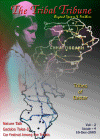Car Festival Among The Tribals
|
Some authors have mentioned about the tradition of car festival among the tribes of Orissa. The discussions of Kasinath Mishra (1983:1-13) and Harihara Kanungo (1983 23-33; may be discussed in this regard.. They have stated that the culture of Orissa is grounded on tirbal culture. As per the discussion of Ptolemy, towards the south of the riverGanga, land of Savaras is situated. May be almost all tribes designated as Savaras during that time. Here the Aryan people or Odras were agriculturist who had close interaction with the Savaras, the original inhabitants of the land. As Kanungo has discussed, in Savara language, the plough is called as Orh or Oroh. In addition to Mundari language, in Tamil and Telugu also Orh is used in connection with agriculture. From this agriculture-oriented word Orh, its Sanskritised version Odra and further Odissa might have been developed. Both the authors have mentioned the tribal deties like Jagamata, Kitung of Saura, Jagaraju of Koya, Jagaya and Jagata of Gadaba to relate to Lord Jagannath. They have discussed about the Thakurani or Bada Yatra ofManyam Konda at Malkangiri. In this festival Koraraju. Jagaraju and Mutyalamma (Suvadra ma) are brought in a procession for Yatra or journey. Two months earlier to the celebration of car festival, the Bada Panda or the priest gets the divine order in dream. After the performance of certain rituals, he goes to the Goddess or Thakurani of the village Manyam Konda near Motu. There the main priest and the other local priests sit on fasting for getting the divine information for the Navakalevara. After getting the information in dream, they go to the instructed site and collect three bamboo shoots. After the shoots started growing to new tender shoots, they bring them with peacock feathers. These three tender shoots are considered as Kora raju (the first oneJaga raju (the second one) and Mutyalamma (the third one) and brought to Malkangiri 32 miles from Manyam Konda in a grand procession. The festival continues for ten days . After the festival closes, they .are taken Gayala hill (from where the shoots were collected) and buried under the ground. It is remarkable that the whole festival has a lot of similarities with that of Navakalevara ceremony of Lord Jagannath. The tribal chiefs like Koya headman, Sukuma raja, Darava raja, Thata-raja of Malkangiriclean the abode of the deities (Just like the Gajapati King of Puri sweeps the cars) Both the authors have also pointed out the car festival of Jalia. They have considered Suvadra of Puri temple as Jalia of the Saora. Saoras usually propitiate three of their deities with special importance, i.e Dharmaboja or Ayungsung (Sun God-Kora raju), Kitung (Jaganta, Jagaraju) and Jalia (Suvadra) Thakurani. Jagata Kitung has ten different types of forms or incarnations whose colour is black. The colour of Jalia is yellow. These deities are Daru or wooden images. In side the house these deities worshipped in an earthern pitcher hanged down from the ceiling. These earthern pitchers are called as Kuduua in Saora language and the earthern pots are called as Kudua in Jagannath temple Puri. Thus, they show a very significant resemblance with each other. In the Jalia Yatra or festival, Ayungsung (Dharmaboja or Sun God) and Kitung move in a procession alongwith Jalia. After the green mango ripes, this festivals celebrated during the month of Puri car festival. In a four-wheeled car, the deities sit alongwith the other two. In the car or chariot, in a basket or box, the dress materials and other ritual objects of Jalia are carried. This is a similar tradition with Goddess Suvadra during the car festival at Puri too. Scholars therefore are of the opinion that from this practice, Puri car festival might have been originated. |
Photographs:
Illustrations:
References:



